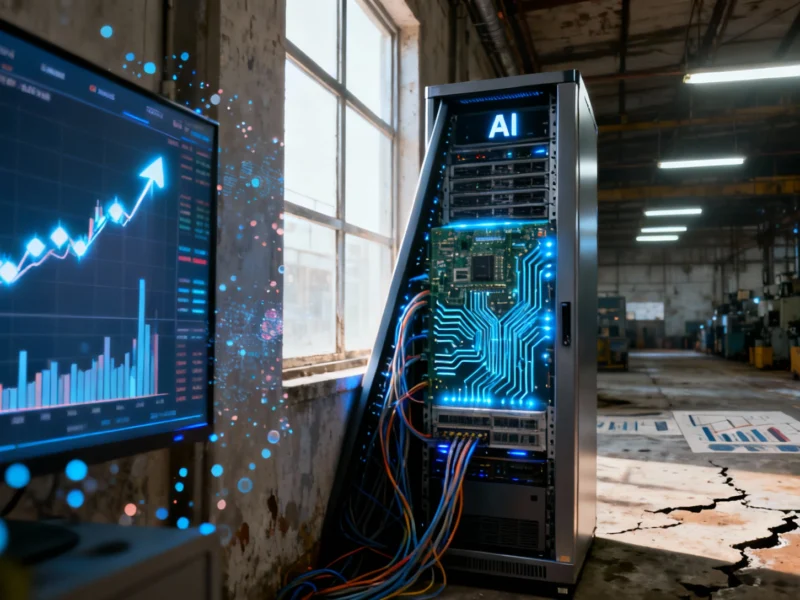The AI boom is creating unprecedented market optimism and lifting GDP through massive infrastructure spending, but many economists worry this artificial intelligence-driven momentum may be concealing underlying economic weakness. While today’s AI giants generate substantial cash flow unlike the unprofitable startups of the dot-com era, the sustainability of current investment levels remains hotly debated among financial experts and market analysts.
The Scale of AI Infrastructure Investment
Global AI investment is forecast to reach $375 billion in 2025 and exceed $500 billion by 2026, according to UBS analysis. This massive capital flood is reshaping economic landscapes and driving what some are calling the fourth Industrial Revolution. “It’s the start of trillions being spent in this build out of the fourth Industrial Revolution,” said Dan Ives, managing director at Wedbush Securities.
“Big tech right now is doing the equivalent of building Vegas in the 1950s where there was just sand. Dubai 30 years ago. That’s what’s happening with this AI infrastructure build out from the chips to the data centers to the grid. You’re really building out the future economy for consumers and enterprises,” he added, emphasizing the transformative scale of current developments in artificial intelligence.
Economic Vulnerabilities Beneath the Surface
Despite the apparent strength, a September 2025 analysis from Deutsche Bank suggested that without AI-related investment, the US economy might already be in a recession. “GDP is being driven by all this investment,” said Barry Knapp, managing partner at Ironsides Macroeconomics, referencing how gross domestic product metrics are being artificially boosted. “Earnings growth is being driven by all this investment. The S&P 500… [is] pretty unbalanced right now.”
Key concerns highlighted by economists include:
- Concentrated market leadership in few AI-focused companies
- Record levels of corporate debt financing infrastructure expansion
- Weakness in traditional economic sectors and labor markets
- Government spending at unprecedented levels alongside private investment
Comparisons to Historical Investment Bubbles
Many analysts are drawing parallels to the dot-com bubble of the late 1990s, though with crucial differences. Unlike that era where companies often had minimal revenue, today’s AI leaders like Oracle, Meta, and CoreWeave are generating substantial cash flow even as they issue billions in debt to fund expansion. Recent SEC filings show the extensive capital raising activities supporting this infrastructure build-out.
“As we go through the rest of these incredible estimates of how much capital is going to be required to build out this infrastructure to avoid seeing electricity prices continue to go up for the public, is going to require a lot of debt over time,” Knapp warned, highlighting the financing challenges ahead.
Labor Market Concerns Amid AI Expansion
While capital flows into AI infrastructure, traditional economic indicators show potential weakness. “The labor market looks very, very weak to me,” Knapp added. “It’s on the precipice of a more pronounced decline.” This disconnect between AI investment and broader economic health is particularly concerning given current employment market uncertainties and ongoing global trade tensions affecting multiple sectors.
The Geopolitical AI Arms Race
Beyond pure economic considerations, the AI investment surge is being driven by strategic competition between global powers. “The reality is it’s an arms race US versus China,” Ives noted. “And they don’t have time to slow down because China is accelerating as well. And I think that’s bullish in terms of the spending continuing.” This geopolitical dimension adds another layer of complexity to investment decisions and market dynamics.
Long-Term Outlook and Investment Sustainability
Despite the risks, many investors remain optimistic about the long-term potential. “Will there be bumps along the road? Yeah but I don’t fear that this is too big to fail given it’s propped up by tech. Trillions on the balance sheet, generating another $3 to $400 billion of cash a year,” Ives argued, pointing to the substantial financial resources available to major technology companies.
As the AI infrastructure build-out continues, market participants will be watching carefully whether this represents a genuine economic transformation or a potential bubble in the making. The coming quarters will be crucial in determining whether current investment levels can be sustained and whether the benefits will spread beyond the technology sector to the broader economy.



